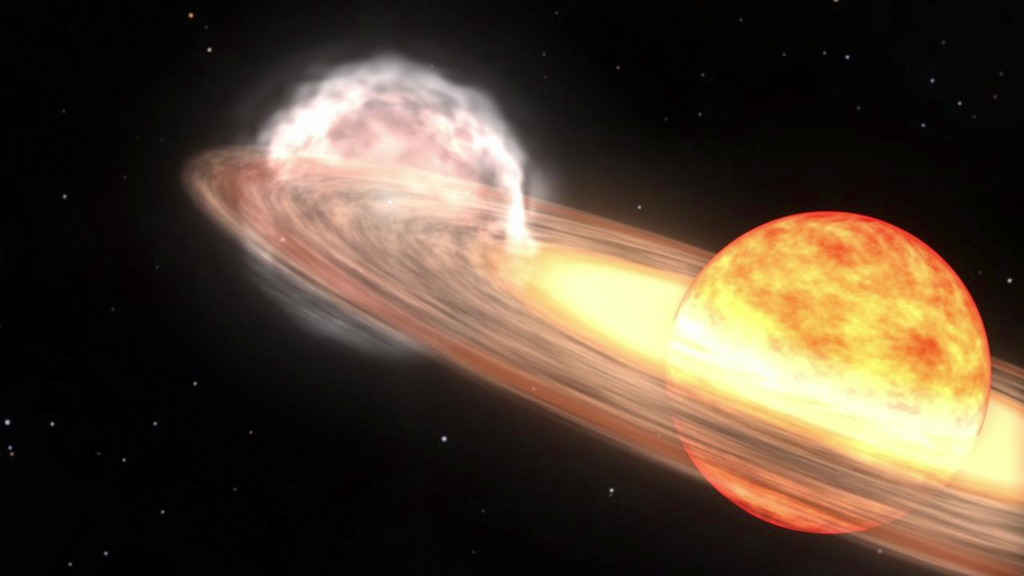Fermi Reveals Novae as a New Class of Gamma-Ray Sources
Observations of four stellar eruptions, called novae, by NASA's Fermi Gamma-ray Space Telescope firmly establish that these relatively common outbursts nearly always produce gamma rays, the most energetic form of light.
A nova is a sudden, short-lived brightening of an otherwise inconspicuous star caused by a thermonuclear explosion on the surface of a white dwarf, a compact star not much larger than Earth. Novae occur because a stream of gas flowing from the star continually piles up into a layer on the white dwarf's surface. This layer eventually reaches a flash point and detonates in a runaway thermonuclear explosion.
Each nova releases up to 100,000 times the annual energy output of our sun. Prior to Fermi, no one suspected these outbursts were capable of producing high-energy gamma rays. Such emission, with energies millions of times greater than visible light, usually is associated with far more powerful cosmic blasts.
Fermi's Large Area Telescope (LAT) scored its first nova detection in March 2010 with an outburst of V407 Cygni. In this rare type of system, a white dwarf interacts with a red giant star more than a hundred times the size of our sun. Other members of this unusual stellar class have been observed to "go nova" every few decades.
In 2012 and 2013, the LAT found three much more typical, or "classical," novae: V339 Delphini in 2013 and V1324 Scorpii and V959 Monocerotis in 2012. The outbursts occurred in comparatively common systems where a white dwarf and a sun-like star orbit each other every few hours.
Astronomers estimate that between 20 and 50 novae occur each year in our galaxy. Most go undetected, their visible light obscured by intervening dust and their gamma rays dimmed by distance. All of the gamma-ray novae found so far lie between 9,000 and 15,000 light-years away, which is relatively nearby compared to our galaxy's size.
One explanation for the gamma-ray emission is that the blast creates multiple shock waves, which expand into space at slightly different speeds. Faster shocks could interact with slower ones, accelerating particles to near the speed of light. These particles ultimately could produce gamma rays.

The white dwarf star in V407 Cygni, shown here in an artist's concept, went nova in 2010. Scientists think the outburst primarily emitted gamma rays (magenta) as the blast wave plowed through the gas-rich environment near the system's red giant star.
Credit: NASA's Goddard Space Flight Center/S. Wiessinger

Novae typically originate in binary systems containing sun-like stars, as shown in this artist's rendering. A nova in a system like this likely produces gamma rays (magenta) through collisions among multiple shock waves in the rapidly expanding shell of debris.
Credit: NASA's Goddard Space Flight Center/S. Wiessinger

These images show Fermi data centered on each of the four gamma-ray novae observed by the LAT. Colors indicate the number of detected gamma rays with energies greater than 100 million electron volts (blue indicates lowest, yellow highest).
Credit: NASA/DOE/Fermi LAT Collaboration

Same as above but without labels.
Credit: NASA/DOE/Fermi LAT Collaboration
For More Information
Credits
Please give credit for this item to:
NASA's Goddard Space Flight Center. However, individual items should be credited as indicated above.
-
Producer
- Scott Wiessinger (USRA)
-
Science writer
- Francis Reddy (University of Maryland College Park)
-
Graphics
- Francis Reddy (University of Maryland College Park)
-
Illustrator
- Scott Wiessinger (KBR Wyle Services, LLC)
Release date
This page was originally published on Thursday, July 31, 2014.
This page was last updated on Wednesday, May 3, 2023 at 1:50 PM EDT.

